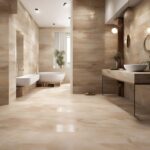Ergonomics is a major factor when setting up today’s offices. Office jobs now lead in many work fields around Australia, so furniture design and its effect on staff health and output get serious attention. Ergonomics means planning and arranging things so people and tools work together easily and safely. In day-to-day jobs, people change desk shape and adjust tools or chairs to fit each person’s body. These days, choosing ergonomic furniture is not only for comfort, this decision can change health, job mood, and health results over months or years.
Adjustable furniture options are growing fast for workplace wellness. Things like chairs that lift or lower, stands for monitors, and desks for sitting or standing can be found in Australia’s offices. Such products help stop problems that start from too much sitting, like sore backs, bad blood flow, and muscle trouble. More buyers now search for a standing desk Perth and show greater belief in active work zones. Moving between sit and stand many times in one day helps lower pressure and gets people to shift and stretch, which may give more focus and higher alertness.

Effects of Long-Term Sitting on the Body
Normal office jobs keep workers in their seats for hours daily. It sounds simple, but reports point out that sitting for too long brings big health worries. Problems appear — back pain can last, neck can get stiff, and risks like getting overweight or having heart trouble also get higher after long sitting. People are not made to stay still for big parts of the day, so the stress adds up and is often not noticed at first. Non-stop sitting, even with correct posture, can push down the spine and slow the blood flow, which gives energy loss and sore muscles. Solving this needs more than getting up for short breaks. Best practice is to plan offices that support easy shifting and body support for a range of poses. Ergonomic furniture is the main solution here. Good picks in furniture let users keep upright, healthy positions and shift seats or stances through the day. People at home and in company offices now know they need good plans to stay healthy at work for years to come.
Important Parts of Ergonomic Office Chairs
The office chair is at the center of an ergonomic work plan. Usual office seats do not move or shape to fit long hours at desks. Chairs made for ergonomics can match different bodies and use times. Main parts include seats that go higher or lower, support for the lower back, and backrests that move so spines line up right. A key target is removing stress from areas like lower back, shoulders, and hips. Getting the correct chair takes looking past look or price. The seat should make users stay active as they work, which means little shifts to work muscles each hour. Leaning back a small bit can drop pressure on the spine, and armrests that move help stop wrist and upper arm strain. In Australia, many bosses now want better chairs to keep office spaces healthy. The change comes from people wanting this and also more proof that ergonomic ideas mean fewer days off work and more jobs finished.
The Value of Good Desks in Ergonomic Spaces
Desks should not be forgotten in healthy office design. How high a desk sits affects posture both when typing and watching a monitor. Desks at a bad height can make users bend or reach too far, which causes wrist, back, or neck pressure. Raising or lowering the desk is a fix that lets people fit work tools to their build. With sit-stand desks or adjustable-height desks in use, people don’t just keep one pose. Both government and private offices in Australia use these as more workers look to beat the down sides of long sitting. As tips and gear spread, more people in workplaces can fill their needs with work setups that change for them.

Building a Full Ergonomic Work Area
Getting a space right for the body needs more than chair and desk. The top of each monitor should face the eyes to keep neck pain away. Place mouse and keyboard so the arms stay relaxed, and hands, wrists, and elbows form simple lines. Light in the space also keeps eyes from feeling tired. Add-ons like foot stools or holders for work papers, plus ways to keep wires neat, make work better and keep order. Putting money in ergonomic setups is a smart way to cut injuries and raise how well people work. Businesses in Australia that know and apply these steps often see less sick leave, better staff moods, and jobs done faster. With more home or mix-work time, setups that fit each worker make the most sense. Careful picks for furniture let both staff and owners find a better, fitter way to reach work targets.
















